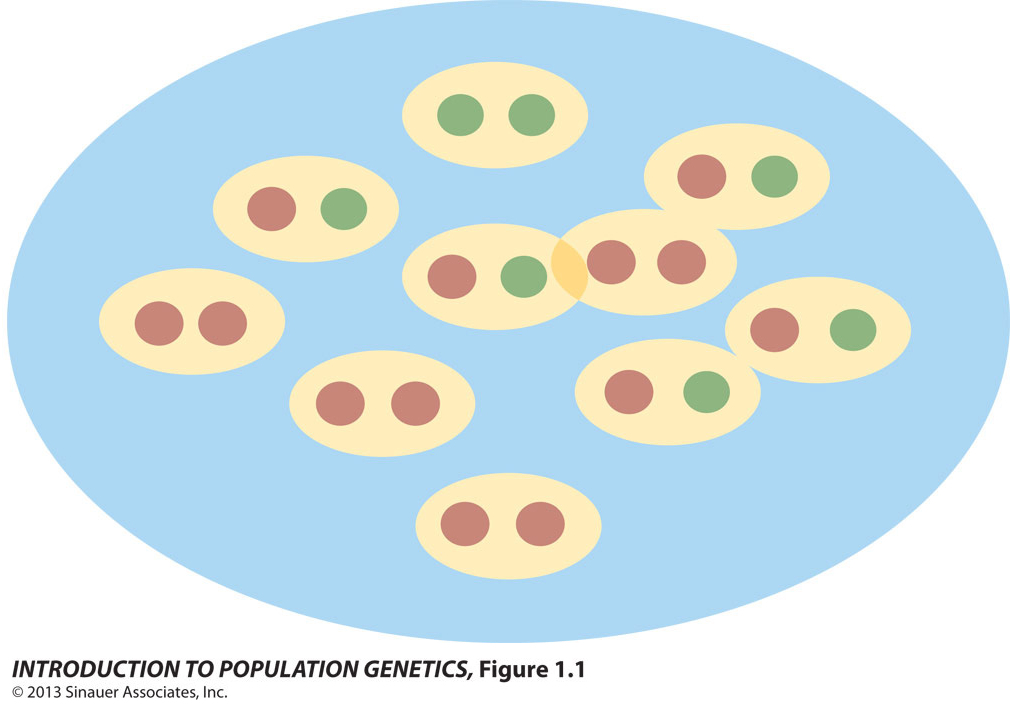
A Diploid Gene Pool
A diploid gene pool that comprises N individuals
has 2N alleles at each gene.
The gene pool shown above has N = 10
individuals with 2 alleles @, therefore 20
alleles (gene copies) total. Let A and
a
symbolize the green and brown alleles, respectively. Allele
frequencies are fA =
7/20 = 0.35, and fa =
13/20 = 0.65. Genotype frequencies are fAA
= 1/10 = 0.1, fAa = 5/10 =
0.5, and faa = 4/10 = 0.4. If
allele frequencies are written as fA
= p and fa =
q, then p = 0.35 and q = 0.65.
Note that q = (1 - p) = 0.65.
Important note: Population and evolutionary geneticists by convention talk about "gene frequencies" when they actually mean "allele frequencies". In this course, we use only the latter term. Talking about "gene frequencies" has several unfortunate implications. These include mathematical confusion as to "gene frequencies" when 10 "genes" have 20 "alleles". More importantly, it is often said (inaccurately) that a person with a predisposition to a particular genetic disease or other condition has the "gene" for that condition, whereas unaffected people "lack the gene". Such predispositions are typically associated with particular alleles at a gene locus [singular: hard "c": 'LOW-kuss']. In evolutionary genetics, we are more interested in allelic variation prevalent in populations that may or may not affect Fitness [to be defined], but which is not medically significant.
Humans typically have two alleles for each of a standard set of 20,050 paired loci [plural: soft "c": 'LOW-sigh'], each at the same physical position locus on 22 pairs of autosomes. These are expressed as proteins in the standard exome set. Loci located on the sex chromosomes are present in two copies on the two X chromosomes in XX females, and in one copy in XY males. Alleles on the Y chromosome are present only in males. Some individuals may have a partial or complete deletions or duplications of a chromosome, which deletes or adds one or more loci, or a rearrangement of part or all of a chromosome. [This paragraph shows that the word 'gene' is easily avoided in favor of 'locus' and 'allele'].
Important note: Population and evolutionary geneticists by convention talk about "gene frequencies" when they actually mean "allele frequencies". In this course, we use only the latter term. Talking about "gene frequencies" has several unfortunate implications. These include mathematical confusion as to "gene frequencies" when 10 "genes" have 20 "alleles". More importantly, it is often said (inaccurately) that a person with a predisposition to a particular genetic disease or other condition has the "gene" for that condition, whereas unaffected people "lack the gene". Such predispositions are typically associated with particular alleles at a gene locus [singular: hard "c": 'LOW-kuss']. In evolutionary genetics, we are more interested in allelic variation prevalent in populations that may or may not affect Fitness [to be defined], but which is not medically significant.
Humans typically have two alleles for each of a standard set of 20,050 paired loci [plural: soft "c": 'LOW-sigh'], each at the same physical position locus on 22 pairs of autosomes. These are expressed as proteins in the standard exome set. Loci located on the sex chromosomes are present in two copies on the two X chromosomes in XX females, and in one copy in XY males. Alleles on the Y chromosome are present only in males. Some individuals may have a partial or complete deletions or duplications of a chromosome, which deletes or adds one or more loci, or a rearrangement of part or all of a chromosome. [This paragraph shows that the word 'gene' is easily avoided in favor of 'locus' and 'allele'].
Figure © 2013 Sinauer Associates; Text material © 2025 by Steven M. Carr